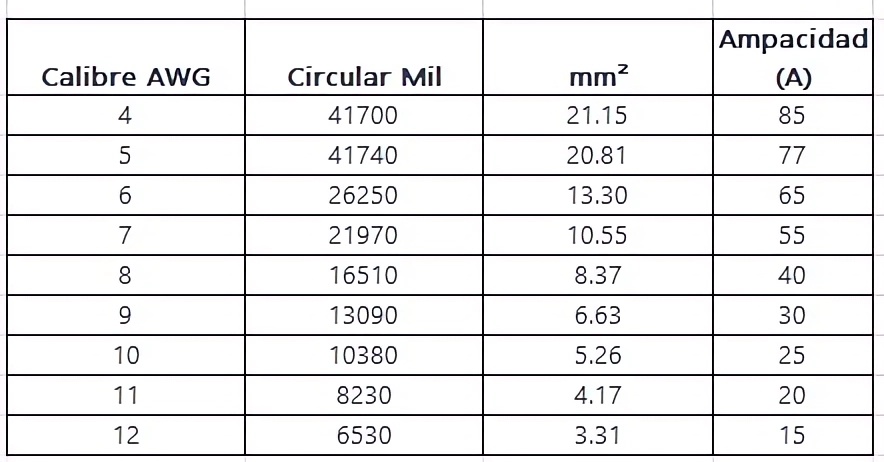AC/DC Power
Choosing electric conductors for dc installations
Electric conductors are essential elements in any electrical installation. Their selection for DC installations differs from the procedure used in AC.
On the other hand, for the process of acquiring this material, it is important to know that cable is not the same as a conductor. For this, we recommend the post Cables and electrical conductors: generalities. We guarantee it will be very enlightening!
How to select conductors for a DC installation?
A correct selection of the conductor gauge will ensure the proper functioning of the equipment. It will also prevent risks of short circuits and fires due to undersizing. Similarly, it avoids unnecessary expenses caused by excessive oversizing.
Given the above, the choice of a conductor is based on the fulfillment of 2 conditions. They refer to:
- Current capacity or ampacity
- Voltage drop
Next, we will see how to apply these concepts in conductor sizing.
Selection of electrical conductors based on ampacity in DC installations
The ampacity is the ability of a conductor to carry a certain amount of current without overheating or deteriorating.
In the case of conductor selection, the current flowing through it should not exceed 80% of its capacity. This capacity is given by the conductor tables.
An example is presented in the following image.

Next, we give you the procedure to follow to select the conductor gauge based on ampacity in DC installations.
- Determine the maximum current consumption of the equipment to be powered. If you don’t have it, you can find it on the data label or in the equipment manual. Let’s call this current IMAX.
- Then perform the following operation:

Finally, select from the above table the conductor gauge whose ampacity is equal to or immediately higher.
Selection of conductors based on voltage drop

Voltage drop is a phenomenon that results from the inherent resistance of the conductor. As shown in the DC circuit image above. It’s important to note that ideally, conductors have no resistance.
However, in reality, due to the material they are made of, they possess a resistance per unit length. Although very small, it exists and must be taken into account for conductor selection.
For a more detailed explanation, you can refer to the article Cables and electrical conductors: resistivity and electrical resistance. Don’t miss out on reading it!
In the DC circuit image above, we have:
VEQUIPO = VDC – 2 x VRC
The result of the multiplication 2xVRC is the value of the voltage drop due to the resistance of the conductors. For more details, refer to Voltage drop in dc electrical conductors.
You can calculate this phenomenon in two ways:
- Using the inherent resistivity of the conductor material, as detailed in the article DC voltage drop in electrical conductors due to electrical resistance
- By using the commercial conductivity factor of the conductor material, presented in Calculation of DC voltage drop by commercial conductivity factor
We recommend using the second method mentioned, as it is simpler and more accurate.
Once you have calculated the voltage drop, you will obtain the minimum section to be used. Therefore, you just need to choose the conductor gauge whose area is equal to or greater than this section.
Remember that a higher conductor gauge is more expensive. In the table in the previous subtitle, we present different conductors with their gauges and sections in three gauges.
What characteristics should the selected electrical conductor have?
The conductor gauge to choose is the larger one obtained by ampacity and voltage drop. For example, if the ampacity suggests a 12 AWG conductor but the voltage drop recommends an 8 AWG, then the final selection will be an 8 AWG conductor.
In the Course on sizing and designing DC power systems for telecommunications and critical systems, we explain all the details. It also includes a practical example that will clarify all your doubts. Get it now!
With your purchase, you are entitled to 10 free personalized consultations for 6 months. To know its content, click here.
Remember that cable selection depends on working conditions. This includes choosing the appropriate insulation.
On the other hand, we clarify that conductor tables give you the section value as if they were solid conductors. This is not true for those made up of several strands.
So we suggest you read How to calculate the effective section of a conductor, which we have prepared for you, and it will clarify this point. Don’t miss it!
In conclusion
Selecting the appropriate conductor for your DC installation is of utmost importance. Remember that in this system, as the voltage is low, the conductor must carry relatively high currents to maintain power.
In the energydcac blog, we provide diverse content on alternative energies and DC topics. We invite you to read them as they will surely be very useful. Until next time!

